Optimizing Sediment Diversion Operations: Working Group Recommendations for Integrating Complex Ecological and Social Landscape Interactions
Abstract
:1. Introduction
2. Materials and Methods
3. Results
3.1. Objectives of a Sediment Diversion
3.1.1. Land-Building Objective
3.1.2. Secondary Objective
3.2. Hydrograph Typologies
3.3. Initial Operations
3.3.1. Geology and Hydrodynamics
3.3.2. Habitats and Fish and Wildlife Species
3.4. Winter Operations
3.4.1. Geology and Hydrodynamics
3.4.2. Habitats and Fish and Wildlife Species
3.5. Spring and Summer Operations
3.5.1. Geology and Hydrodynamics
3.5.2. Habitats
3.5.3. Fish and Wildlife Species
- The American alligator (Alligator mississippiensis) prefers fresh marshes and will cease feeding over 10 parts per thousand (ppt) [89]. Sediment diversions are anticipated to increase the habitat quality and quantity for the alligator. Initial operations do not have to be as concerned as most of the outfall area is currently intermediate and brackish marsh, but the population will grow over time as more fresh habitats are created. American alligators can be negatively affected by water depths or stressed vegetation during the nesting season (mid-May to early September) [90]. Once a substantial population establishes, future operational strategies will need to consider minimizing extensive flooding during the nesting season, although the loss of a single year of nesting will not be detrimental to the entire population [90].
- Blue crabs (Callinectes sapidus) in Barataria basin account for 18% of the state harvest [91] and have specific salinity requirements for various stages of their life cycle. Diversion operations should be most concerned with minimizing affects to mating females in March to May and during the peak spawning period, August to September [92]. Any estuarine recovery in May could also facilitate larval recruitment into Barataria basin [93].
- The Eastern oyster (Crassostrea virginica) is a sessile animal that relies on distinct salinity regimes. The ideal mean salinity from May to September for subtidal oysters is 10 to 20 ppt [94] although 5 to 15 ppt is commonly used for an annual range. High salinity limitations (>20 ppt) are not a physiological response, but a predator and disease response. Extended low salinity (<5 ppt) during hot summer months (>25 °C) significantly affect oyster recruitment, survival and growth [95,96,97]. Oyster reefs can survive fresh water inputs in the winter months as long as the diversion operations are reduced or ceased by March. Occasionally, episodic flood events (every 3 to 5 years) during the spring or summer can cause high mortality that could potentially benefit oyster populations and reef health by reducing predator pressure, reducing the occurrence of disease, and providing shell for reefs to rebuild [98].
- Diversions will increase habitats for most wetland mammals, including important fur-bearing species and invasive animals, as well as waterfowl and other water birds. Diversions will lead to increased habitat quality, quantity, and diversity, including submerged aquatic vegetation (SAVs). Increased nutrients from diversion operations are likely to result in increased marsh damage from invasive species, such as nutria and feral hogs [99,100] and management programs may need to be expanded to address the increased herbivory. In addition, some species of birds nest on or just above the marsh surface in the spring and summer, which could be disrupted by a rapid rising of water level elevations from the opening of a diversion. Most species would re-nest if water levels recede within the nesting season (March to July), but even if they do not, other years without spring/summer flooding could offset losses during flood years.
- White shrimp (Litopenaeus setiferus) seem to be more euryhaline than brown shrimp and able to tolerate lower salinities [101]. Diversion operations with minimal to no flow during summer to early fall should not affect offshore spawning of white shrimp, although spawning can occur in nearshore Gulf waters. Additionally, such minimal to no flow will likely have minimal effect on postlarvae recruitment, which occurs mostly in June and July, and juvenile development from July to December [102]. Over the past few decades, the relative abundance of brown to white shrimp has varied based on environmental conditions and fishing pressure. Potentially, diversion operations could shift the relative abundance and commercial influences to more white shrimp than brown shrimp.
- Barataria basin accounts for 44% of the inshore brown shrimp (Farfantepenaeus aztecus) harvest in Louisiana [102]. Diversion operations are unlikely to affect brown shrimp spawning which occurs further offshore, however postlarvae shrimp migrate inshore from February to April and spend March to July in the estuary as juveniles. If opened in late winter to early spring, a sediment diversion could have an effect on postlarvae recruitment into the estuary unless the diversion closing and estuary salinity recovery was timed with recruitment stages.
4. Discussion
5. Conclusions
Acknowledgments
Author Contributions
Conflicts of Interest
References
- Ericson, J.P.; Vörösmarty, C.J.; Dingman, S.L.; Ward, LG.; Meybeck, M. Effective sea-level rise and deltas: Causes of change and human dimension implications. Glob. Planet. Chang. 2006, 50, 63–82. [Google Scholar] [CrossRef]
- Giosan, L.; Syvitski, J.; Constantinescu, S.; Day, J. Protect the world’s deltas. Nature 2014, 516, 31–33. [Google Scholar] [CrossRef] [PubMed]
- Coastal Protection and Restoration Authority of Louisiana (CPRA). Louisiana’s Coastal Master Plan for a Sustainable Coast; Coastal Protection and Restoration Authority of Louisiana: Baton Rouge, LA, USA, 2012.
- Peyronnin, N.S.; Green, M.; Richards, C.P.; Owens, A.; Reed, D.; Chamberlain, J.; Groves, D.G.; Rhinehart, K.; Belhadjali, K. Louisiana’s 2012 coastal master plan: Overview of a science-based and publicly informed decision-making process. J. Coast. Res. 2013, 67, 1–15. [Google Scholar] [CrossRef]
- Coastal Protection and Restoration Authority of Louisiana (CPRA). Louisiana’s Coastal Master Plan for a Sustainable Coast; Coastal Protection and Restoration Authority of Louisiana: Baton Rouge, LA, USA, 2017.
- Gagliano, S.M. An approach to multiuse management in the Mississippi Delta system. In Deltas: Models for Exploration; Broussard, M.L., Ed.; Houston Geological Society: Houston, TX, USA, 1975; pp. 223–238. [Google Scholar]
- Paola, C.; Twilley, R.; Edmonds, D.; Kim, W.; Mohrig, D.; Parker, G. Natural processes in delta restoration: Application to the Mississippi delta. Ann. Rev. Mar. Sci. 2011, 3, 67–91. [Google Scholar] [CrossRef] [PubMed]
- Gagliano, S.; Coleman, J. Cyclic Sedimentation in the Mississippi River Deltaic Plain. Gulf Coast Assoc. Geol. Soc. Trans. 1964, 14, 67–80. [Google Scholar]
- Wells, J.T.; Coleman, J.M. Wetland Loss and the Subdelta Life Cycle. Estuar. Coast. Shelf Sci. 1987, 25, 111–125. [Google Scholar] [CrossRef]
- Barry, J.M. Rising tide: The great Mississippi flood of 1927 and how it changed America. In Touchstone, 1st ed.; Simon & Schuster: New York, NY, USA, 1998; pp. 1–524. ISBN 0684840022. [Google Scholar]
- Davis, D.W. Crevasses on the lower course of the Mississippi River. In Coastal Zone ’93; American Society of Civil Engineers: New York, NY, USA, 1993; pp. 360–378. [Google Scholar]
- Day, J.; Kemp, G.P.; Freeman, A.; Muth, D.P. Perspectives on the Restoration of the Mississippi Delta: The Once and Future Delta; Day, J., Kemp, G.P., Freeman, A., Muth, D.P., Eds.; Springer: New York, NY, USA, 2014. [Google Scholar]
- Craig, N.J.; Turner, R.E.; Day, J.W. Land loss in coastal Louisiana. Environ. Manag. 1979, 3, 133–144. [Google Scholar] [CrossRef]
- Boesch, D.F.; Josselyn, M.N.; Mehta, A.J.; Morris, J.T.; Nuttle, W.K.; Simenstad, C.A.; Swift, D.J. Scientific assessment of coastal wetland loss, restoration and management in Louisiana. J. Coast. Res. 1994, i–v, 1–103. [Google Scholar]
- Kesel, R.H. The role of the Mississippi River in wetland loss in southeastern Louisiana, USA. Environ. Geol. Water Sci. 1989, 13, 183–193. [Google Scholar] [CrossRef]
- Couvillion, B.R.; Barras, J.A.; Steyer, G.D.; Sleavin, W.; Fischer, M.; Beck, H.; Trahan, N.; Griffin, B.; Heckman, D. Land Area Change in Coastal Louisiana from 1932 to 2010; U.S. Geological Survey: Reston, VA, USA, 2011.
- Roberts, H.H. Dynamic changes of the holocene Mississippi river delta plain: The delta cycle. J. Coast. Res. 1997, 13, 605–627. [Google Scholar]
- Kolker, A.S.; Allison, M.A.; Hameed, S. An evaluation of subsidence rates and sea-level variability in the northern Gulf of Mexico. Geophys. Res. Lett. 2011, 38, L21404. [Google Scholar] [CrossRef]
- Day, J.W.; Boesch, D.F.; Clairain, E.J.; Kemp, G.P.; Laska, S.B.; Mitsch, W.J.; Orth, K.; Mashrigui, H.; Reed, D.J.; Shabman, L.; et al. Restoration of the Mississippi Delta: Lessons from Hurricanes Katrina and Rita. Science 2007, 315, 1679–1684. [Google Scholar] [CrossRef] [PubMed]
- Gagliano, S.M.; Hyuck, J.K.; Van Beek, J.L. Deterioration and restoration of coastal wetlands. Coast. Eng. Proc. 1970, 12, 1767–1781. [Google Scholar] [CrossRef]
- Tripp, J.T.; Herz, M. Wetland preservation and restoration: Changing federal priorities. Va. J. Nat. Res. 1987, 7, 221. [Google Scholar]
- Louisiana Coastal Wetlands Planning, Protection and Restoration Act (CWPPRA) Program. Louisiana Coastal Wetlands Restoration Plan: Main Report, Environmental Impact Statement and Appendices; U.S. Army Corps of Engineers; U.S. Department of Agriculture; U.S. Department of Commerce; U.S. Department of the Interior; U.S. Environmental Protection Agency; Louisiana Department of Natural Resources: Baton Rouge, LA, USA, 1993.
- Louisiana Coastal Wetlands Conservation and Restoration Task Force and the Wetlands Conservation and Restoration Authority (LCWCRTF). Coast 2050: Toward a Sustainable Coastal Louisiana; Louisiana Department of Natural Resources: Baton Rouge, LA, USA, 1998.
- Coastal Protection and Restoration Authority of Louisiana (CPRA). Integrated Ecosystem Restoration and Hurricane Protection: Louisiana’s Comprehensive Master Plan for a Sustainable Coast; Coastal Protection and Restoration Authority of Louisiana: Baton Rouge, LA, USA, 2007.
- Twilley, R.R.; Couvillion, B.R.; Hossain, I.; Kaiser, C.; Owens, A.B.; Steyer, G.D.; Visser, J.M. Coastal Louisiana ecosystem assessment and restoration program: The role of ecosystem forecasting in evaluating restoration planning in the Mississippi river deltaic plain. Am. Fish. Soc. Symp. 2008, 64, 29–46. [Google Scholar]
- Kim, W.; Mohrig, D.; Twilley, R.; Paola, C.; Parker, G. Is it feasible to build new land in the Mississippi River Delta? EOS Trans. Am. Geophys. Union 2009, 90, 373–374. [Google Scholar] [CrossRef]
- Gagliano, S.M.; Culley, P.; Earle, D.W., Jr.; King, P.; Latiolas, C.; Light, P.; Rowland, A. Environmental Atlas and Multiuse Management Plan for South Central Louisiana; Louisiana State University: Baton Rouge, LA, USA, 1973. [Google Scholar]
- Wang, H.; Chen, Q.; Hu, K.; LaPeyre, M.K. A modeling study of the impacts of the Mississippi River diversion and sea-level rise on water quality of a deltaic estuary. Estuar. Coast. 2016, 6, 1–27. [Google Scholar] [CrossRef]
- Soniat, T.M.; Conzelmann, C.P.; Byrd, J.D.; Roszell, D.P.; Bridevaux, J.L.; Suir, K.J.; Colley, S.B. Predicting the effects of proposed Mississippi River diversions on oyster habitat quality; Application of an oyster habitat suitability index model. J. Shellfish Res. 2013, 32, 629–638. [Google Scholar] [CrossRef]
- Peyronnin, N.; Caffey, R.; Cowan, J.H., Jr.; Dubravko, J.; Kolker, A.; Laska, S.; McCorquodale, A.; Melancon, E., Jr.; Nyman, J.A.; Twilley, R.; et al. Building Land in Coastal Louisiana: Expert Recommendations for Operating a Successful Sediment Diversion that Balances Ecosystem and Community Needs. Available online: http://www.mississippiriverdelta.org/files/2016/07/MRDRC_OWG_Main_Electronic.pdf (accessed on 15 March 2017).
- Meselhe, E.A.; Georgiou, I.; Allison, M.A.; McCorquodale, J.A. Numerical modeling of hydrodynamics and sediment transport in lower Mississippi at a proposed delta building diversion. J. Hydrol. 2012, 472, 340–354. [Google Scholar] [CrossRef]
- U.S. Army Corps of Engineers (USACE). Ecosystem Restoration Study: Louisiana Coastal Area (LCA), Louisiana, Volume 1: LCA Main Report; U.S. Army Corps of Engineers: Baton Rouge, LA, USA, 2004. Available online: www.lca.gov/Library/FileDownload.aspx?ProdType=0&id=1137 (accessed on 15 March 2017).
- Milliman, J.D.; Farnsworth, K.L.; Jones, P.D.; Xu, K.H.; Smith, L.C. Climatic and anthropogenic factors affecting river discharge to the global ocean, 1951–2000. Glob. Planet. Chang. 2008, 62, 187–194. [Google Scholar] [CrossRef]
- Tao, B.; Tian, H.; Ren, W.; Yang, J.; Yang, Q.; He, R.; Cai, W.; Lohrenz, S. Increasing Mississippi river discharge throughout the 21st century influenced by changes in climate, land use, and atmospheric CO2. Geophys. Res. Lett. 2014, 41, 4978–4986. [Google Scholar] [CrossRef]
- Nakaegawa, T.; Kitoh, A.; Hosaka, M. Discharge of major global rivers in the late 21st century climate projected with the high horizontal resolution MRI-AGCMs. Hydrol. Process 2013, 27, 3301–3318. [Google Scholar] [CrossRef]
- Falloon, P.D.; Betts, R.A. The impact of climate change on global river flow in HadGEMI simulations. Atmos. Sci. Lett. 2006, 7, 62–68. [Google Scholar] [CrossRef]
- Melillo, J.M.; Richmond, T.C.; Yohe, G.W. Climate Change Impacts in the United States: The Third National Climate Assessment. U.S. Glob. Chang. Res. Program 2014, 841. [Google Scholar] [CrossRef]
- McCorquodale, J.A. Hydrograph Topologies and Sediment Regimes for Evaluation of Operating a Diversion. 2017; submitted for publication. [Google Scholar]
- Kolker, A.S.; Miner, M.D.; Weathers, H.D. Depositional Dynamics in a River Diversion Receiving Basin: The Case of the West Bay Mississippi River Diversion. Estuar. Coast. Shelf Sci. 2012, 106, 1–12. [Google Scholar] [CrossRef]
- Shaw, J.B.; Mohrig, D. The importance of erosion in distributary channel network growth, Wax Lake Delta, Louisiana, USA. Geology. 2014, 42, 31–34. [Google Scholar] [CrossRef]
- Wilson, C.A.; Allison, M.A. An Equilibrium Profile Model for Retreating Marsh Shorelines in Southeast Louisiana. Estuar. Coast. Shelf Sci. 2008, 80, 483–494. [Google Scholar] [CrossRef]
- Esposito, C.R.; Georgiou, I.Y.; Kolker, A.S. Hydrodynamic and Geomorphic Controls on Mouth Bar Evolution. Geophys. Res. Lett. 2013, 40, 1540–1545. [Google Scholar] [CrossRef]
- Lopez, J.; Henkel, T.; Moshogianis, A.; Baker, A.; Boyd, E.; Hillman, E.; Batker, D. Evolution of Mardi Grad Pass within the Bohemia Spillway of the Mississippi Delta in Southeast Louisiana: March 2012 through December 2013; Lake Pontchartrain Basin Foundation: New Orleans, LA, USA, 2014. [Google Scholar]
- Lacey, G. Stable Channels in Alluvium; Institution of Civil Engineers: London, UK, 1929; Volume 229, pp. 258–384. [Google Scholar]
- Cao, S.; Knight, D.W. Review of regime theory of alluvial channels. J. Hydrodyn. Ser. B 2002, 3, 1–3. [Google Scholar] [CrossRef]
- Connor, P.F.; Lopez, J.; Henkel, T.; Hillmann, E.; Smith, P.; Baker, D.; Butcher, K. Hydrocoast Salinity Maps 1:1,100,000, Lake Pontchartrain Basin Foundation, 2016. Available online: http://saveourlake.org/lpbf-programs/coastal/hydrocoast-maps (accessed on 17 March 2017).
- Wellner, R.; Beaubouef, R.; Van Wagoner, J.; Roberts, H.; Sun, T. Jet-plume depositional bodies—The primary building blocks of Wax Lake Delta. Gulf Coast Assoc. Geol. Soc. Trans. 2005, 55, 867–909. [Google Scholar]
- Wright, L. Sediment transport and deposition at river mouths: A synthesis. Geol. Soc. Am. Bull. 1977, 88, 857. [Google Scholar] [CrossRef]
- Snedden, G.; Steyer, G. Predictive occurrence models for coastal wetland plant communities: Delineating hydrologic response surfaces with multinomial logistic regression. Estuar. Coast. Shelf Sci. 2013, 118, 11–23. [Google Scholar] [CrossRef]
- Snedden, G.; Cretini, K.; Patton, B. Inundation and salinity impacts to above and belowground productivity in Spartina patens and Spartina alterniflora in the Mississippi River deltaic plain: Implications for using river diversions as restoration tools. Ecol. Eng. 2015, 81, 133–139. [Google Scholar] [CrossRef]
- Visser, J.M.; Sandy, E.R. The effects of flooding on four common Louisiana marsh plants. Gulf Mex. Sci. 2009, 21–29. [Google Scholar] [CrossRef]
- Allison, M.A.; Meselhe, E.A. The Use of Large Water and Sediment Diversions in the Lower Mississippi River (Louisiana) for Coastal Restoration. J. Hydrol. 2010, 387, 346–360. [Google Scholar] [CrossRef]
- Thomson, D.; Shaffer, G.; McCorquodale, J.A. A potential interaction between sea-level rise and global warming: Implications for coastal stability on the Mississippi River Deltaic Plain. J. Glob. Planet. Chang. 2001, 670, 49–59. [Google Scholar] [CrossRef]
- Feng, Z.; Li, C. Cold-front-induced flushing of the Louisiana Bays. J. Mar. Syst. 2010, 82, 252–264. [Google Scholar] [CrossRef]
- Allison, M.A.; Demas, D.; Ebersole, B.; Kleiss, B.; Little, C.; Meselhe, E. A water and sediment budget for the lower Mississippi–Atchafalaya River in flood years 2008–2010: Implications for sediment discharge to the oceans and coastal restoration in Louisiana. J. Hydrol. 2012, 432–433, 84–97. [Google Scholar] [CrossRef]
- Reed, D.J. Patterns of sediment deposition in subsiding coastal salt marshes, Terrebonne Bay, Louisiana: The role of winter storms. Estuaries 1989, 12, 222. [Google Scholar] [CrossRef]
- Roberts, H.; Oscar, K.; Walters, S. Winter Storm Impacts on Chenier Plain Coast of Southwestern Louisiana. Gulf Coast Assoc. Geol. Soc. Trans. 1989, 39, 73. [Google Scholar]
- Carle, M.; Sasser, C.; Roberts, H. Accretion and vegetation community change in the Wax Lake Delta following the historic 2011 Mississippi River flood. J. Coast. Res. 2015, 313, 569–587. [Google Scholar] [CrossRef]
- Freeman, A.; Jose, F.; Roberts, H.; Stone, G. Storm induced hydrodynamics and sediment transport in a coastal Louisiana lake. Estuar. Coast. Shelf Sci. 2015, 161, 65–75. [Google Scholar] [CrossRef]
- Roberts, H.H.; De Laune, R.D.; White, J.; Li, C.; Braud, D.; Weeks, E. Delta Development and Coastal Marsh Accretion During Cold Front Passages and River Floods: Relevance to River Diversions—Final Report; Coastal Studies Institute, Louisiana State University: Baton Rouge, LA., USA, 2016. [Google Scholar]
- Roberts, H.H.; DeLaune, R.D.; White, J.R.; Li, C.; Sasser, C.E.; Braud, D.; Weeks, E.; Khalil, S. Floods and Cold Front Passages: Impacts on Coastal Marshes in a River Diversion Setting (Wax Lake Delta Area, Louisiana). J. Coast. Res. 2015, 31, 1057–1068. [Google Scholar] [CrossRef]
- Shaffer, G.P.; Sasser, C.E.; Gosselink, J.G.; Rejmanek, M. Vegetation dynamics in the emerging Atchafalaya Delta, Louisiana, USA. J. Ecol. 1992, 80, 677–687. [Google Scholar] [CrossRef]
- Visser, J.; Peterson, J. The effects of flooding duration and salinity on three common upper estuary plants. Wetlands 2015, 35, 625–631. [Google Scholar] [CrossRef]
- Van Zomeren, C.M.; White, J.R.; DeLaune, R.D. Fate of nitrate in vegetated brackish coastal marsh. Soil Sci. Soc. Am. J. 2012, 76, 1919–1927. [Google Scholar] [CrossRef]
- Reddy, K.R.; De Laune, R.D. Biogeochemistry of Wetlands: Science and Applications; CRC Press: Boca Raton, FL, USA, 2008; ISBN-10: 1566706785. [Google Scholar]
- Das, A.; Justic, D.; Inoue, M.; Hoda, A.; Huang, H.; Park, D. Impacts of Mississippi River diversions on salinity gradients in a deltaic Louisiana estuary: Ecological and management implications. Estuar. Coast. Shelf Sci. 2012, 111, 17–26. [Google Scholar] [CrossRef]
- Meselhe, E.A.; Sadid, K.M.; Allison, M.A. Riverside morphological response to pulsed sediment diversions. Geomorphology 2016, 270, 184–202. [Google Scholar] [CrossRef]
- Das, A.; Justic, D.; Swenson, E. Modeling estuarine-shelf exchanges in a deltaic estuary: Implications for coastal carbon budgets and hypoxia. Ecol. Model. 2010, 221, 978–985. [Google Scholar] [CrossRef]
- Roblin, R. Water Quality Modeling of Freshwater Diversions in the Pontchartrain Estuary. Masters’s Thesis, University of New Orleans, New Orleans, LA, USA, 2008. [Google Scholar]
- Rivera-Monroy, V.H.; Branoff, B.; Meselhe, E.; McCorquodale, A.; Dortch, M.; Steyer, G.D.; Visser, J.; Wang, H. Landscape-level estimation of nitrogen removal in coastal Louisiana wetlands: Potential sinks under different restoration scenarios. J. Coast. Res. 2013, 67, 75–87. [Google Scholar] [CrossRef]
- Justic, D.; Rabalais, N.; Turner, R. Coupling between climate variability and coastal eutrophication: Evidence and outlook for the northern Gulf of Mexico. J. Sea Res. 2005, 54, 25–35. [Google Scholar] [CrossRef]
- Roy, E.D.; Smith, E.A.; Bargu, S.; White, J.R. Will Mississippi River diversions designed for coastal restoration cause harmful algal blooms in receiving estuaries? Ecol. Eng. 2016, 91, 350–364. [Google Scholar] [CrossRef]
- Dettmann, E.H. Effect of water residence time on annual export and denitrification of nitrogen in estuaries: A model analysis. Estuaries 2001, 24, 481–490. [Google Scholar] [CrossRef]
- Lane, R.R.; Day, J.W.; Justic, D.; Reyes, E.; Marx, B.; Day, J.N.; Hyfield, E. Changes in stoichiometric Si, N and P ratios of Mississippi River water diverted through coastal wetlands to the Gulf of Mexico. Estuar. Coast. Shelf Sci. 2004, 60, 1–10. [Google Scholar] [CrossRef]
- Huang, H.; Justic, D.; Lane, R.; Day, J.; Cable, J. Hydrodynamic response of the Breton Sound estuary to pulsed Mississippi River inputs. Estuar. Coast. Shelf Sci. 2011, 95, 216–231. [Google Scholar] [CrossRef]
- Perez, B.; Day, J.W.; Justic, D.; Lane, R.R.; Twilley, R.R. Nutrient stoichiometry, freshwater residence time, and nutrient retention in a river-dominated estuary in the Mississippi Delta. Hydrobiol. 2011, 658, 41–54. [Google Scholar] [CrossRef]
- Sklar, F.H.; Browder, J.A. Coastal environmental impacts brought about by alterations to freshwater flow in the Gulf of Mexico. Coast. Manag. 1998, 22, 547–562. [Google Scholar] [CrossRef]
- Sasser, C.E.; Visser, J.M.; Mouton, E.; Linscombe, J.; Hartley, S.B. Vegetation Types in Coastal Louisiana in 2013. U.S. Geolog. Surv. Sci. Investig. Map 3290 2014. [Google Scholar] [CrossRef]
- Visser, J.; Duke-Sylvester, S.; Carter, J.; Broussard, W. A computer model to forecast wetland vegetation changes resulting from restoration and protection in coastal Louisiana. J. Coast. Res. 2013, 67, 51–59. [Google Scholar] [CrossRef]
- Nyman, J.; Baltz, D.; Kaller, M.; Leberg, P.; Richards, C.; Romaire, R.; Soniat, T. Likely changes in habitat quality for fish and wildlife in coastal Louisiana during the next fifty years. J. Coast. Res. 2013, 67, 60–74. [Google Scholar] [CrossRef]
- Cowan, J.H., Jr.; Grimes, C.B.; Shawn, R.F. Life history, history, hysteresis and habitat changes in Louisiana’s coastal ecosystem. Bull. Mar. Sci. 2008, 83, 197–215. [Google Scholar]
- Baltz, D.; Rakocinski, C.; Fleeger, J. Microhabitat use by marsh-edge fishes in a Louisiana estuary. Environ. Biol. Fishes 1993, 36, 109–126. [Google Scholar] [CrossRef]
- Rozas, L.; Zimmerman, R. Small-scale patterns of nekton use among marsh and adjacent shallow nonvegetated areas of the Galveston Bay Estuary, Texas (USA). Mar. Ecol. Prog. Ser. 2000, 193, 217–239. [Google Scholar] [CrossRef]
- Browder, J.; Bartley, H.; Davis, K. A probabilistic model of the relationship between marshland-water interface and marsh disintegration. Ecol. Model. 1985, 29, 245–260. [Google Scholar] [CrossRef]
- Browder, J.; May, L.; Rosenthal, A.; Gosselink, J.; Baumann, R. Modeling future trends in wetland loss and brown shrimp production in Louisiana using thematic mapper imagery. Remote Sens. Environ. 1989, 28, 45–59. [Google Scholar] [CrossRef]
- Lewis, K.A.; de Mutsert, K.; Steenbeek, J.; Peele, J.; Cowan, J.H.; Buszowski, J. Employing ecosystem models and geographic information systems (GIS) to investigate the response of changing marsh edge on historical biomass of estuarine nekton in Barataria Bay, Louisiana, USA. Ecol. Model. 2016, 331, 129–141. [Google Scholar] [CrossRef]
- Fry, B.; Cieri, M.; Hughes, J.; Tobias, C.; Deegan, L.; Peterson, B. Stable isotope monitoring of benthic–planktonic coupling using salt marsh fish. Mar. Ecol. Prog. Ser. 2008, 369, 193–204. [Google Scholar] [CrossRef]
- De Mutsert, K.; Cowan, J.; Walters, C. Using Ecopath with Ecosim to explore nekton community response to freshwater diversion into a Louisiana estuary. Mar. Coast. Fish. 2012, 4, 104–116. [Google Scholar] [CrossRef]
- Laurén, D.J. The effect of chronic saline exposure on the electrolyte balance, nitrogen metabolism, and corticosterone titer in the American alligator, Alligator mississippiensis. Comp. Biochem. Phys. A 1985, 81, 217–223. [Google Scholar] [CrossRef]
- Platt, S.G.; Hastings, R.W.; Brantley, C.G. Nesting ecology of the American alligator in southeastern Louisiana. In Proceedings of the Annual Conference of the Southeastern Association of Fish and Wildlife Agencies, Nashville, TN, USA, 23–27 September 1995; Volume 49, pp. 629–639. [Google Scholar]
- Bourgeois, M.; Marx, J.; Semon, K. Louisiana Blue Crab. In Fishery Management Plan; Louisiana Department of Wildlife and Fisheries: Baton Rouge, LA, USA, 2014; pp. 1–122. [Google Scholar]
- Guillory, V.; Elliot, M. A Review of Blue Crab Predators. In Proceedings of the Blue Crab Mortality Symposium, Lafayette, LA, USA, 28–29 May 1999; Gulf States Marine Fisheries Commission: Ocean Springs, MS, USA, 1999; pp. 69–83. [Google Scholar]
- Jaworski, E. The Blue Crab Fishery, Barataria Estuary, Louisiana; Center for Wetland Resources, Louisiana State University, LSU: Baton Rouge, LA, USA, 1972; Volume LSU-SG-72-01, p. 112. [Google Scholar]
- Cake, E.W., Jr. Habitat Suitability Index Models: Gulf of Mexico American Oyster; US Fish and Wildlife Service: Washington, DC, USA, 1983; Volume FWS/OBS-82/10.57, p. 37.
- LaPeyre, M.K.; Schwarting, L.; Miller, S. Baseline data for evaluating development trajectory and provision of ecosystem services of created fringing oyster reefs in Vermilion Bay, Louisiana. U.S. Geol. Surv. Open-File Rep. 2013, 1053, 43. [Google Scholar]
- Rouhani, S.; Oehrig, J. Generation of Oyster Survival Salinity Dose-Response Curves Using Nestier Tray Data; DWH Oyster NRDA Technical Working Group Report, DHW-AR0270362; NewFields, Inc.: Atlanta, GA, USA, 2015; p. 11. [Google Scholar]
- Rouhani, S.; Oehrig, J. Methodology Used to Determine the Spatial Extent of Fresh Water Impact in Barataria Bay and Black/Bay Breton Sound Basins in 2010; DWH Oyster NRDA Technical Working Group Report, DWH-AR0270373; NewFields, Inc.: Atlanta, GA, USA, 2015; p. 11. [Google Scholar]
- Dugas, R. Oyster Distribution and Density on the Productive Portion of State Seed Grounds in Southeastern Louisiana; Louisiana Department of Wildlife and Fisheries: Baton Rouge, LA, USA, 1977.
- Visser, J.; Sasser, C.; Cade, B. The effect of multiple stressors on salt marsh end-of-season biomass. Estuar. Coast. 2006, 29, 328–339. [Google Scholar] [CrossRef]
- Ialeggio, J.; Nyman, J. Nutria grazing preference as a function of fertilization. Wetlands 2014, 34, 1039–1045. [Google Scholar] [CrossRef]
- Doerr, J.; Liu, H.; Minello, T. Salinity selection by juvenile brown shrimp (Farfantepenaeus aztecus) and white shrimp (Litopenaeus setiferus) in a gradient tank. Estuar. Coast. 2015, 39, 829–838. [Google Scholar] [CrossRef]
- Bourgeois, M.; Landry, L.; Lightner, J.; Marx, J.; Semon, K. Louisiana Shrimp. In Fishery Management Plan; Louisiana Department of Wildlife and Fisheries: Baton Rouge, LA, USA, 2015; pp. 1–158. [Google Scholar]

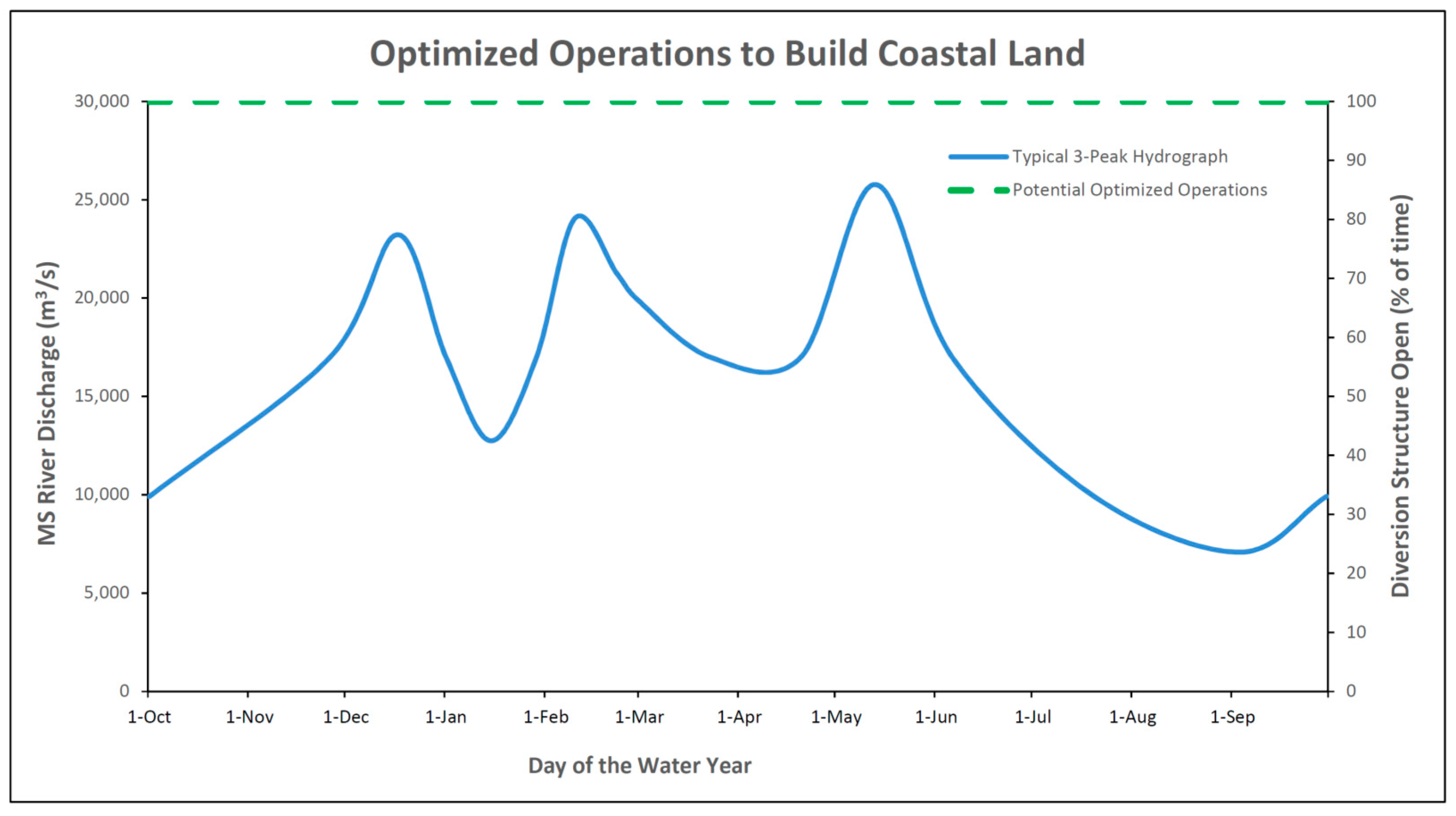
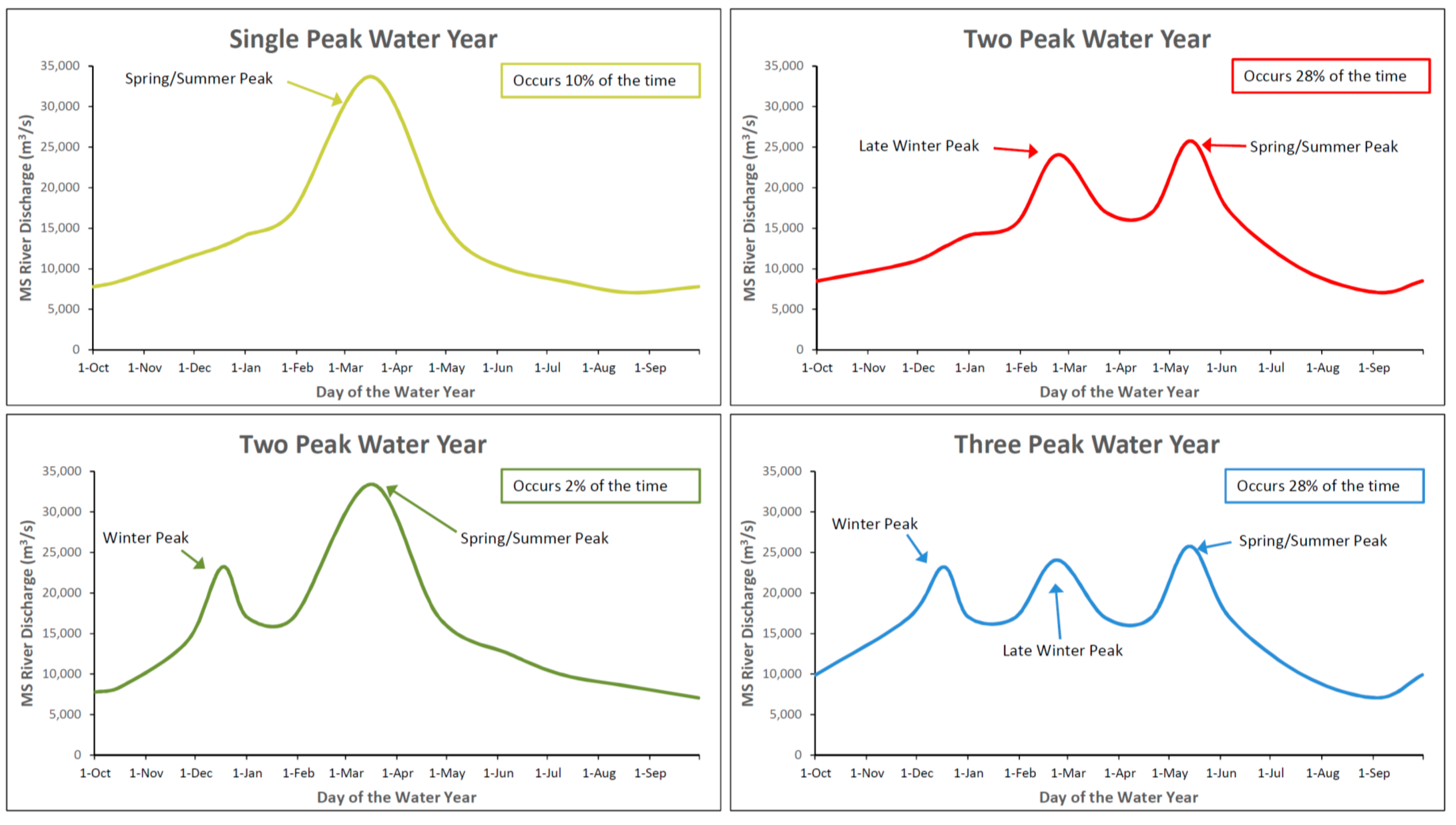

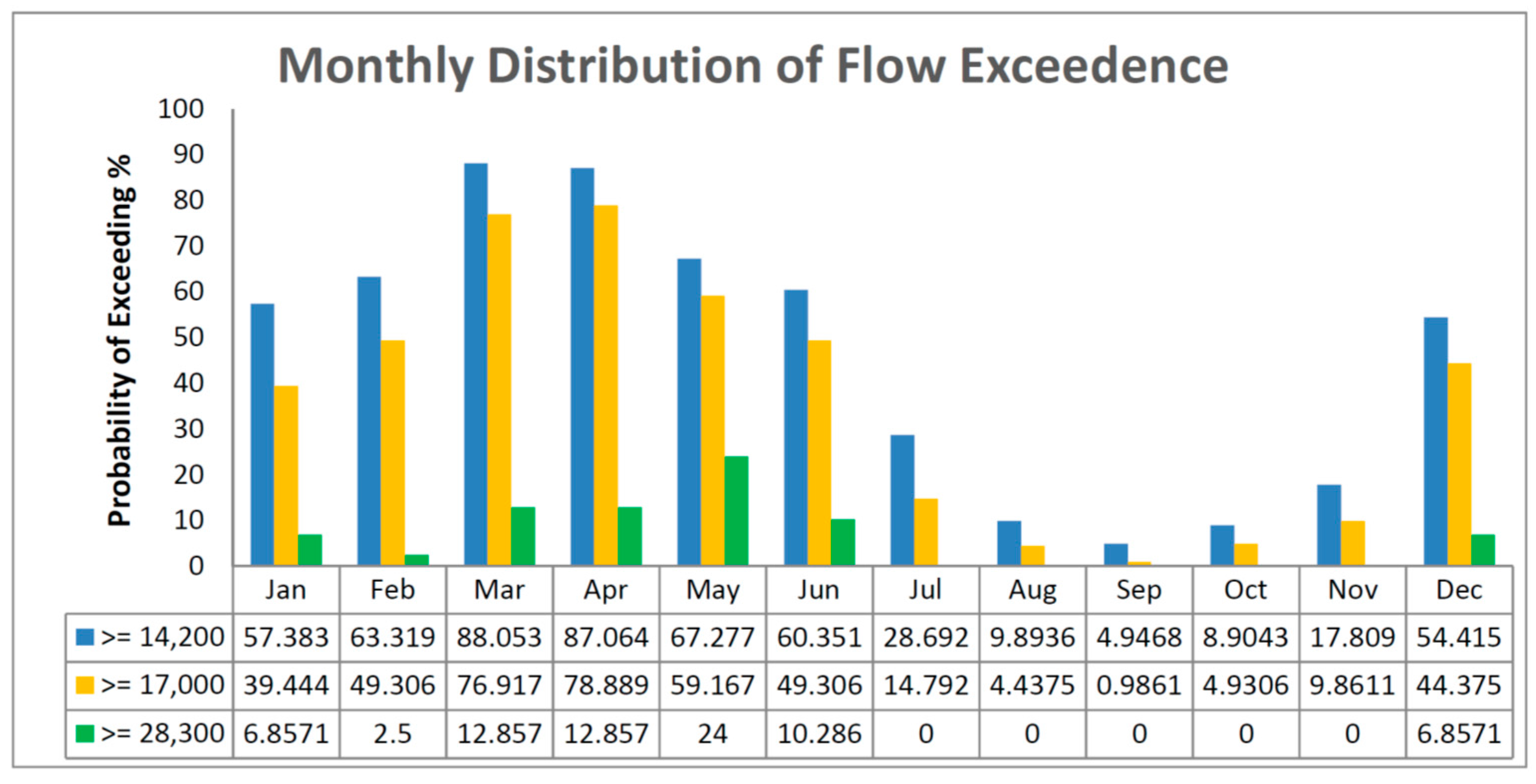
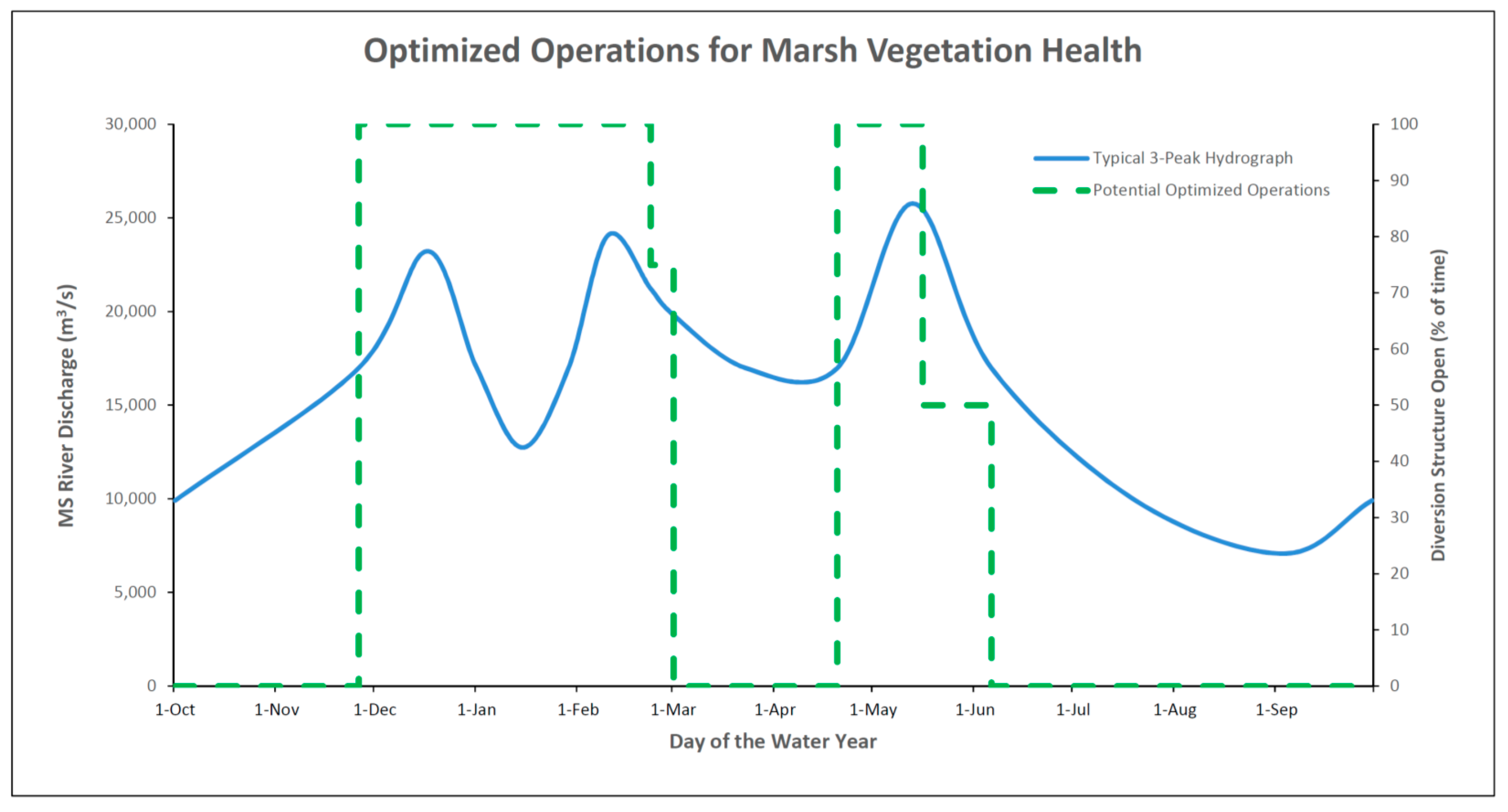
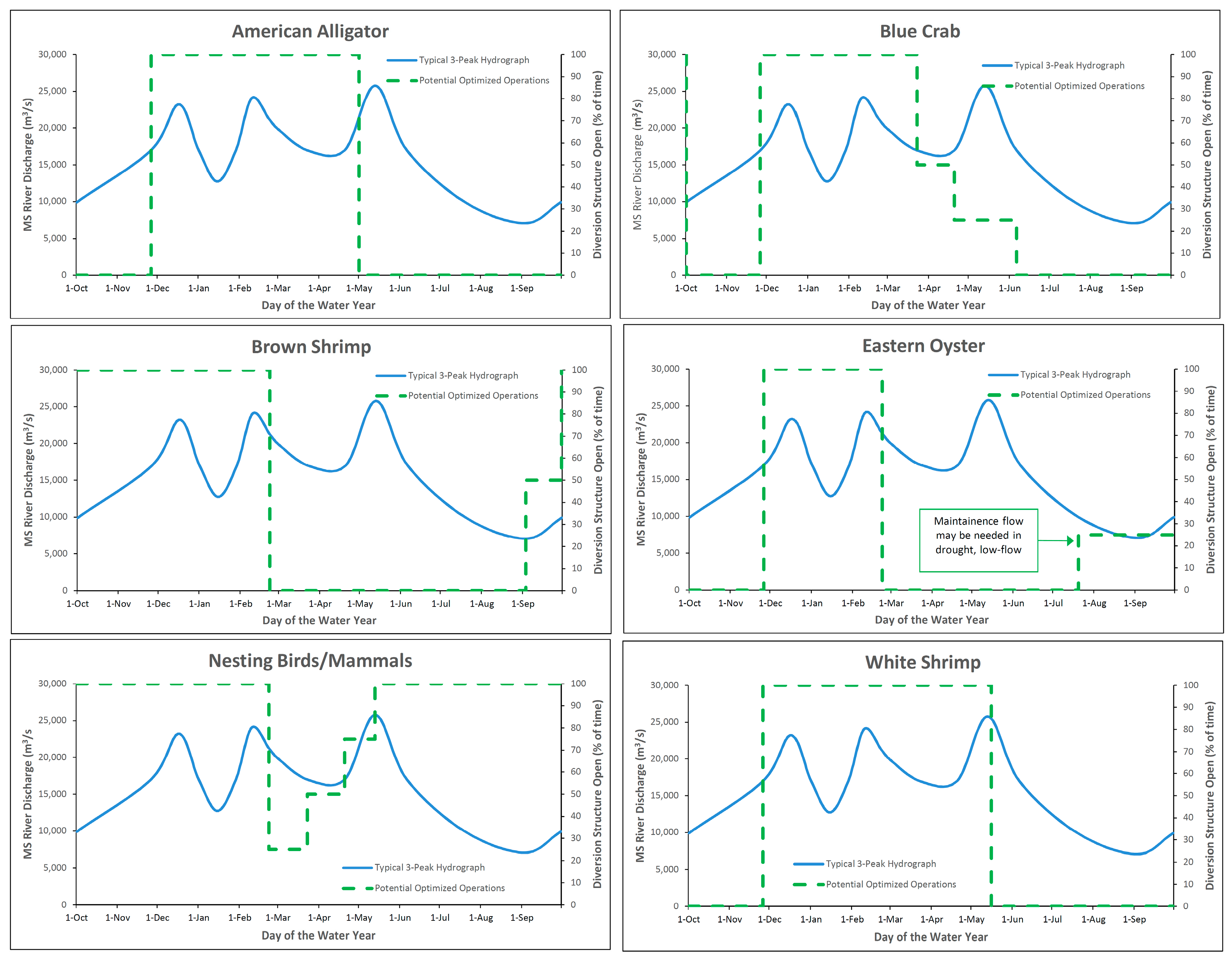
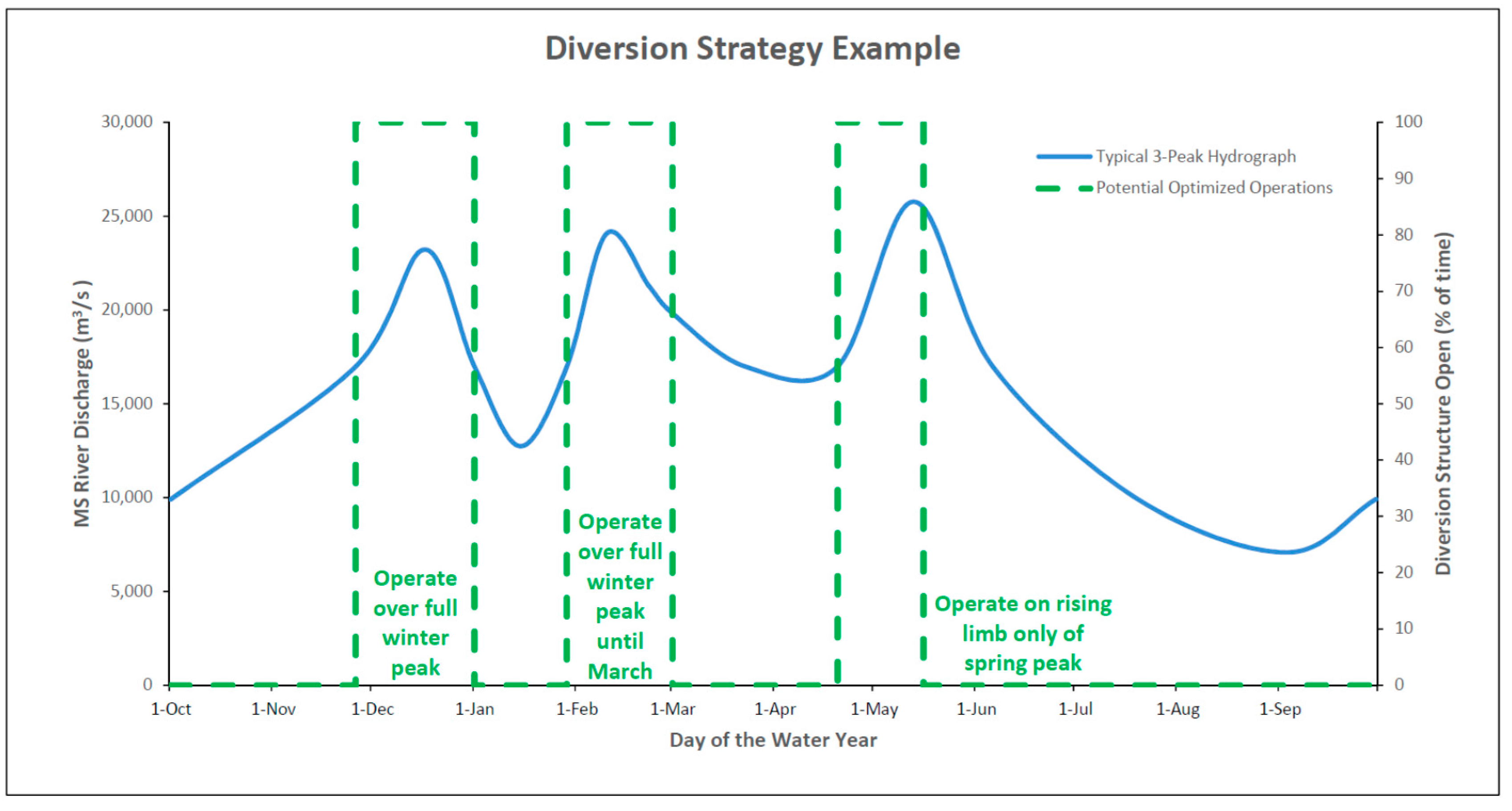
| Meeting Topic | Date | Parameters Discussed |
|---|---|---|
| River Hydrology and Sediment Loads | 16 September 2015 | River flow, stage, velocity, flood peaks, trajectory, sediment concentrations, discharge, sediment transport and budget, sediment-water ratios (SWR), atmospheric conditions, climate change |
| Basin Geology and Land-Building | 16 October 2015 | Delta development (channel evolution, progradation, aggradation, subsidence), seasonal sedimentation, sediment transport, diversion discharge, velocity, sediment retention, cold fronts, turbidity, topography, bathymetry, soil salinity, substrate, erodibility, shear stress/strength |
| Water Quality | 20 November 2015 | Hydrodynamics, residence time, discharge, salinity, temperature, nutrients (flux, load), hypoxia, phytoplankton production, harmful algal blooms, sediment, turbidity, flocculation, disease, pathogens, hormones, pharmaceuticals, cold fronts |
| Wetland Health | 14 December 2015 | Habitat types, estuarine salinity gradients, saltwater intrusion, elevation, vegetation, salinity, invasive vegetation species, sediment (input, quality, composition), bulk density, nutrient loading rates, vegetative biomass, nitrogen availability and uptake, phosphorus, sulfates/sulfides, temperature, respiration rates, duration of flooding, growing season, vegetation stress, saltwater spikes |
| Fish and Wildlife Species | 13 January 2016 | Trophic productivity, salinity, species/community composition, dietary ranges, niche breadth, predator/prey relationships, species distribution, estuarine salinity gradients, habitat quality/value, species abundance, nutrients, water depth, sediment input, fish productivity, eutrophication, fishing practices, life cycles, fishing pressure, mortality, habitat requirements, indicator species |
| Communities, User Groups and Socio-Economics | 17 February 2016 | Economic value, river flow, stage, distributary width, discharge, flood risk, subsidence, sea level rise, storm seasons/surge, tides, salinity, turbidity, temperature, channelization, winds, velocity, elevation, transition costs, compensation, mitigation, sack and seed oyster fisheries, private and public oyster beds, leasing program, oyster cultch, shrimp production, blue crab stock, social behavior, politics, community adaptation, trust |
| Operational Strategies | 14 March 2016 | Hydrograph typologies and various operational strategies |
| Governance, Legal and Stakeholder Involvement | 13 April 2016 | Property rights, negligence, eminent domain, inverse condemnation, oyster lease acquisition and compensation programs, oyster lease dynamics, flow capacity, flow easements, salinity gradients, land trusts, public ownership, conservation easements, advisory groups, frontloading impacts, insurance, decision-making framework, transparency, trust, role of stakeholders, agencies and public officials in operations decisions |
© 2017 by the authors. Licensee MDPI, Basel, Switzerland. This article is an open access article distributed under the terms and conditions of the Creative Commons Attribution (CC BY) license (http://creativecommons.org/licenses/by/4.0/).
Share and Cite
Peyronnin, N.S.; Caffey, R.H.; Cowan, J.H.; Justic, D.; Kolker, A.S.; Laska, S.B.; McCorquodale, A.; Melancon, E.; Nyman, J.A.; Twilley, R.R.; et al. Optimizing Sediment Diversion Operations: Working Group Recommendations for Integrating Complex Ecological and Social Landscape Interactions. Water 2017, 9, 368. https://doi.org/10.3390/w9060368
Peyronnin NS, Caffey RH, Cowan JH, Justic D, Kolker AS, Laska SB, McCorquodale A, Melancon E, Nyman JA, Twilley RR, et al. Optimizing Sediment Diversion Operations: Working Group Recommendations for Integrating Complex Ecological and Social Landscape Interactions. Water. 2017; 9(6):368. https://doi.org/10.3390/w9060368
Chicago/Turabian StylePeyronnin, Natalie S., Rex H. Caffey, James H. Cowan, Dubravko Justic, Alexander S. Kolker, Shirley B. Laska, Alex McCorquodale, Earl Melancon, John A. Nyman, Robert R. Twilley, and et al. 2017. "Optimizing Sediment Diversion Operations: Working Group Recommendations for Integrating Complex Ecological and Social Landscape Interactions" Water 9, no. 6: 368. https://doi.org/10.3390/w9060368
APA StylePeyronnin, N. S., Caffey, R. H., Cowan, J. H., Justic, D., Kolker, A. S., Laska, S. B., McCorquodale, A., Melancon, E., Nyman, J. A., Twilley, R. R., Visser, J. M., White, J. R., & Wilkins, J. G. (2017). Optimizing Sediment Diversion Operations: Working Group Recommendations for Integrating Complex Ecological and Social Landscape Interactions. Water, 9(6), 368. https://doi.org/10.3390/w9060368







